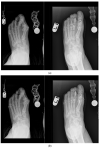Hallux Valgus Repair with Chevron Osteotomy Significantly Narrows Forefoot Width
- PMID: 37048690
- PMCID: PMC10094931
- DOI: 10.3390/jcm12072607
Hallux Valgus Repair with Chevron Osteotomy Significantly Narrows Forefoot Width
Abstract
Background: Hallux valgus (HV) is a common adult foot deformity. There is uncertainty concerning the effect of HV surgery on foot width. We examined the effect of chevron first metatarsal osteotomy on forefoot width using calibrated pre and postoperative standing radiographs.
Methods: A retrospective cohort of 50 patients underwent chevron osteotomy HV surgery. All had HVA > 30°, IMA > 11°, DMMA > 3°, >6-month follow-up, and calibrated pre and postoperative standing foot radiographs. Bony width (BW) and soft tissue width (STW) were used to measure the surgery's effect on foot width. Measurements were made preoperatively and 3-6 months following surgery.
Results: The study group included 42 women with an average age of 63.4 (±8.3) and a mean BMI of 28.7 (±4.9). Preoperative HVA and IMA were 31.7° (±6.8°) and 13.4° (±2.8°), respectively. Following surgery, HVA and IMA improved significantly, by 15.6° (±5.7°) and 8.7° (±2.3°), respectively. The preoperative average BW was 9.4 cm (±0.6), and the STW was 10.6 cm (±0.7). Following surgery, significant changes in BW and STW were measured, with a mean narrowing of 1.2 cm (±0.4) in BW (p < 0.001) and 0.95 cm (±0.5) in STW (p < 0.001). Paradoxically, an increase in age led to a lower correction of the IMA (p = 0.04, r = 0.57), but higher BW and STW reductions (p = 0.01, r = 0.35 and p = 0.008, r = 0.37, respectively).
Conclusions: This study reinforced chevron osteotomy as a valid treatment option that significantly narrows forefoot width; it is thus expected to improve cosmetic outcomes, shoe selection options, and quality of life. This study also found that older age correlates with better forefoot narrowing following hallux valgus repair, possibly due to stiffer soft tissues.
Keywords: chevron osteotomy; forefoot width; hallux valgus (HV); shoe size.
Conflict of interest statement
There are no conflict of interest.
Figures
Similar articles
-
Does Hallux Valgus Correction Reduce the Width of the Forefoot?Foot Ankle Spec. 2020 Apr;13(2):112-115. doi: 10.1177/1938640019835301. Epub 2019 Apr 8. Foot Ankle Spec. 2020. PMID: 30957541
-
Radiographic Forefoot Width Following Minimally Invasive Chevron Akin Bunionectomy.Foot Ankle Orthop. 2023 Jan 23;8(1):24730114221148191. doi: 10.1177/24730114221148191. eCollection 2023 Jan. Foot Ankle Orthop. 2023. PMID: 36755967 Free PMC article.
-
[Surgical management of hallux valgus by techniques preserving the first metatarsophalangeal joint: long-term results].Acta Chir Orthop Traumatol Cech. 2007 Apr;74(2):105-10. Acta Chir Orthop Traumatol Cech. 2007. PMID: 17493411 Czech.
-
Comparison of outcomes of different osteotomy sites for hallux valgus: A systematic review and meta-analysis.J Orthop Surg (Hong Kong). 2022 May-Aug;30(2):10225536221110473. doi: 10.1177/10225536221110473. J Orthop Surg (Hong Kong). 2022. PMID: 35836406
-
Chevron osteotomy versus scarf osteotomy for hallux valgus correction: A meta-analysis.Foot Ankle Surg. 2019 Dec;25(6):755-760. doi: 10.1016/j.fas.2018.09.003. Epub 2018 Oct 6. Foot Ankle Surg. 2019. PMID: 30391038
Cited by
-
[Effectiveness of minimally invasive treatment of hallux valgus with small incision external articular osteotomy].Zhongguo Xiu Fu Chong Jian Wai Ke Za Zhi. 2024 Jul 15;38(7):855-861. doi: 10.7507/1002-1892.202402084. Zhongguo Xiu Fu Chong Jian Wai Ke Za Zhi. 2024. PMID: 39013824 Free PMC article. Chinese.
-
[Comparative study on changes in forefoot width after minimally invasive extra-articular osteotomy via small incision for hallux valgus].Zhongguo Xiu Fu Chong Jian Wai Ke Za Zhi. 2025 Feb 15;39(2):140-145. doi: 10.7507/1002-1892.202411013. Zhongguo Xiu Fu Chong Jian Wai Ke Za Zhi. 2025. PMID: 39971357 Free PMC article. Chinese.
References
-
- Myerson M.S., Badekas A. Hypermobility of the first ray. Foot Ankle Clin. 2000;5:469–484. - PubMed
LinkOut - more resources
Full Text Sources


